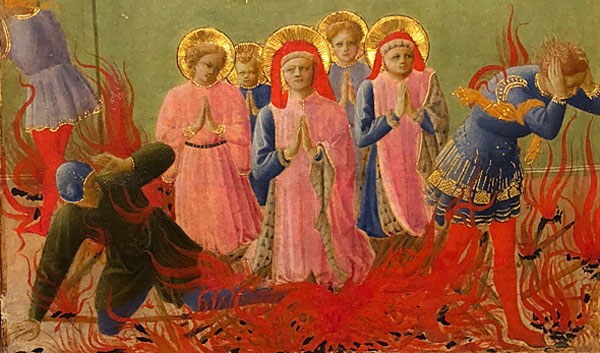Among all the holy men and women of the Church, martyrs have a special place of honor. The word martyr translates as “witness”. This is a man, woman, or child who gave the ultimate witness to Our Lord and to the faith of the Church, by freely laying down their lives. Their death was a public testimony to their faith and fidelity. They are teachers of the gospel to both believers and non-believers, without using any words. Their death was a participation in Christ’s death, and they were held up as loyal heroes of the Church. In his recorded history on the “Martyrs of Palestine”, the bishop and historian Eusebius (d.340) stated that all Christians were dependent upon the powerful intercession of the martyrs from their place in heaven.
Wishing that the heroic deaths and testimonies of the martyrs not be lost or forgotten, the early Church took great care to honor their relics and record their stories. For example, the bishop St. Ignatius of Antioch (d. 107 AD) was martyred in Rome in an amphitheater by being thrown to wild beats in a public amphitheater. Later that day, after the Roman games were complete, Christians quietly gathered up his relics and placed them in fine linen, as if it were a priceless treasure. Another example is the bishop of Smyrna, St. Polycarp (d. 156), who was burned at the stake and pierced with a sword for refusing to burn incense to the Roman gods. After his execution, Christians gathered his relics and described them “as more precious than costly stones”. Lastly, St. Cyprian (d. 258), theologian and bishop of Carthage, was beheaded in a public a square surrounded by the members of his diocese for refusing to renounce his Christian faith. As the executioner blindfolded and prepared Cyprian for death, the Christians placed towels and napkins around their bishop’s body in order to preserve his blood for veneration.
Martyr Saints Cosmas and Damian Burned Alive. detail of a painting by Fra Angelico
************
The eyewitness accounts of the Christian martyrs gave rise to two new genres of literature in the Church. The “Acta” of a martyr was the civil court transcript of their interrogation and execution. It detailed the martyrs last words and deeds during the trail and execution. Often these documents were obtained either by secret purchase or when the executioner converted to Christianity. The “passio” (or passion) of a martyr was more than just facts, it also included theological points, miracles, and symbolism that allowed the audience to see the spiritual context of the death. Both the “acta” and the “passio” of martyrs were promulgated by the local bishop and read at gatherings of the Christians, especially on the anniversary of the martyr’s death known as the “Dies natalis” (birthday into heaven). These accounts from eyewitnesses in the local community were also shared with other communities, thus expanding devotion to the martyr throughout the universal Church.
The great honor given to the martyrs by the early Church is still preserved in the Church today. The date assigned as the feast day of a martyr on the universal Church’s calendar is not the martyr’s birthday, but their anniversary of death (their birthday into heaven). The Liturgy of the Hours (the official Prayer of the Church) still provides portions of a martyr’s “acta” or “passio” on their feast day for the church to read and reflect upon. Images of a martyr in Christian art (ie, statue, stain glass window, icon) normally show the instrument of their martyrdom (sword, wooden cross, stone) taken from their “actta” or “passio”.






 Поменять язык на русский
Поменять язык на русский 